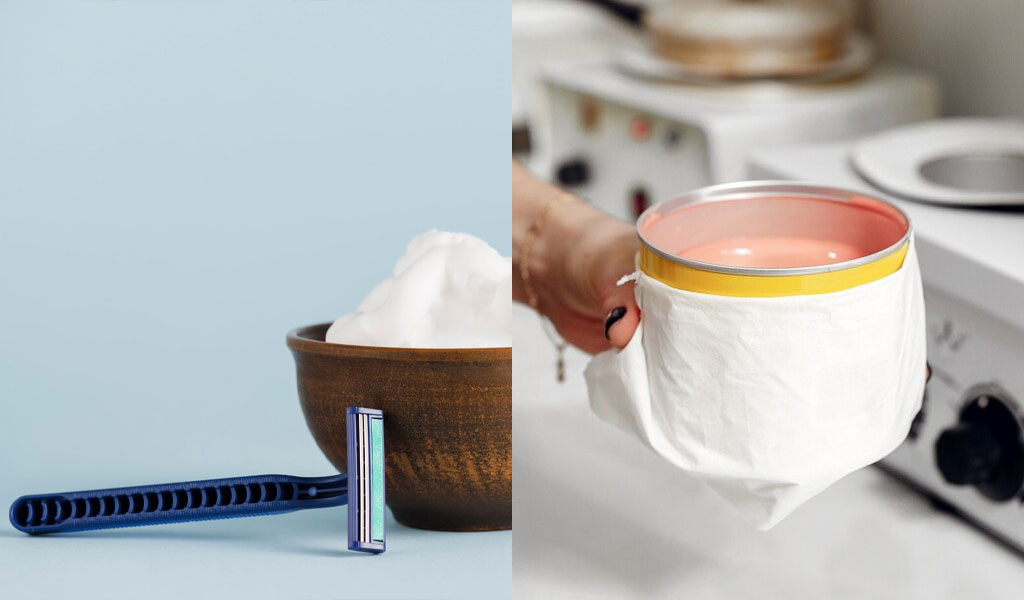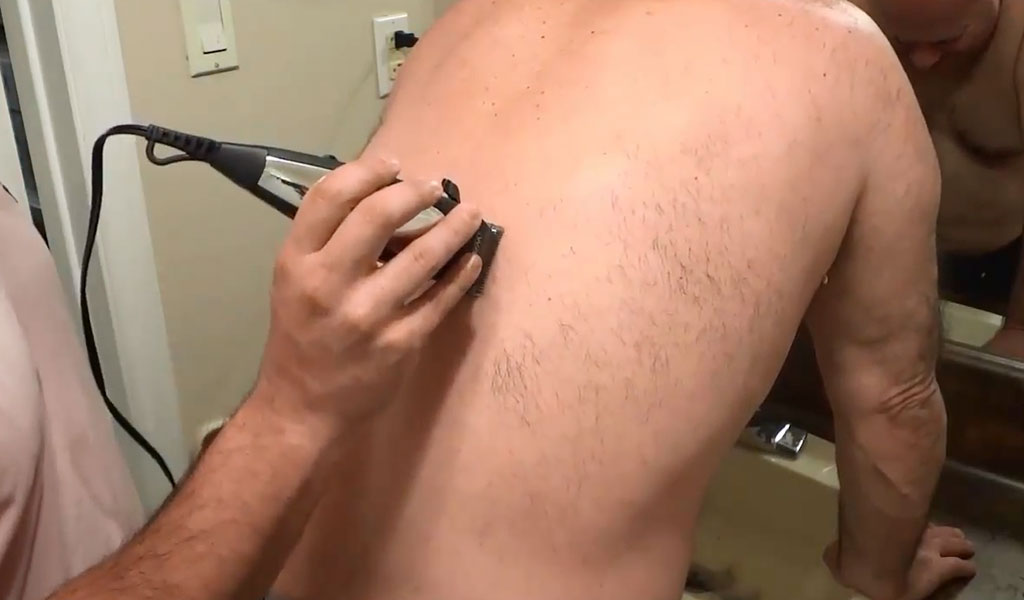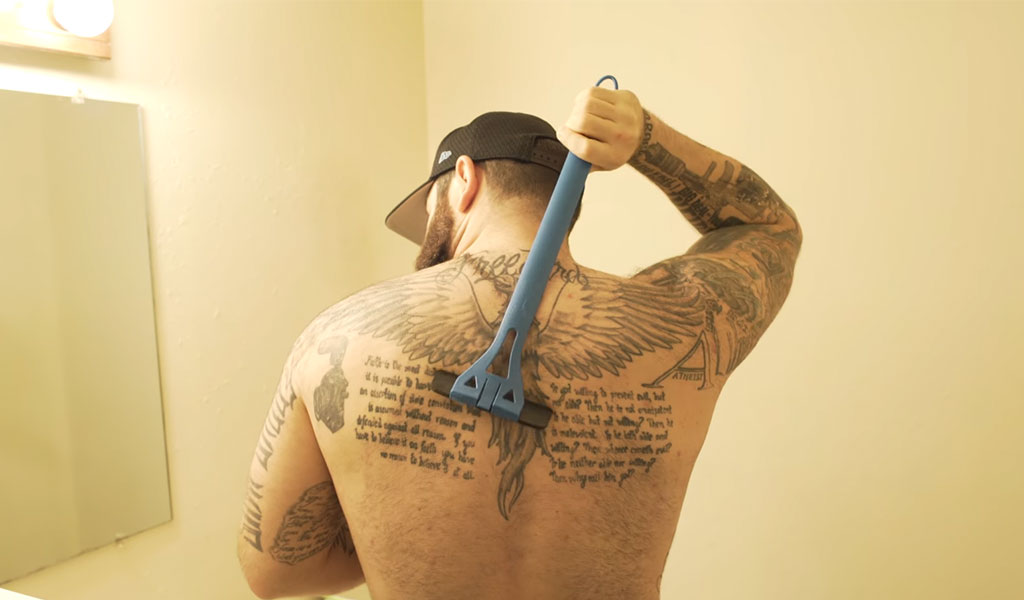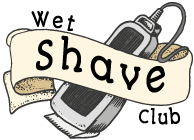Have you ever wondered about the best way to manage your back hair and achieve a smooth, groomed appearance?
Manscaping your back hair is a common grooming practice that many men undertake to enhance their overall appearance and boost their confidence.
Whether you’re preparing for a beach vacation, getting ready for a special occasion, or simply want to feel more comfortable in your own skin, effective back hair manscaping can make a significant difference.
From choosing between shaving and waxing to mastering the proper techniques and aftercare practices, there’s a lot to consider when it comes to tackling back hair.
In this blog, we’ll explore the ins and outs of manscaping your back hair, providing valuable tips and insights to help you achieve the desired results with ease and confidence. Stay sharp.
Understanding Back Hair
Back hair, often overlooked, serves both functional and evolutionary purposes. The human body, including the back, is covered in hair follicles, remnants of our distant ancestors who relied on body hair for warmth and protection.
While back hair may seem excessive in modern times, it still plays a role in regulating body temperature and providing a barrier against environmental elements.
From an evolutionary standpoint, back hair likely served as an aid in thermoregulation, helping early humans adapt to varying climates. Additionally, it may have acted as a form of camouflage or protection against predators.
However, societal norms and personal preferences often lead to the removal or grooming of back hair.
Despite this, understanding the evolutionary significance and functional role of back hair can provide a new perspective on its presence in the human body, highlighting its link to our ancient past and the adaptive mechanisms that have shaped our species over time.
Shaving vs. Waxing: What’s Good for Manscaping Your Back Hair

When it comes to managing back hair, men have traditionally turned to two main methods: shaving and waxing.
Each method has its own set of pros and cons, and the choice between them ultimately depends on individual preferences, pain tolerance, and desired results.
Effectiveness
Shaving: Shaving is a quick and convenient way to remove back hair. With the right tools and technique, shaving can provide smooth results in a matter of minutes.
However, it’s worth noting that shaving only removes hair at the surface level, meaning regrowth occurs relatively quickly.
Waxing: Waxing, on the other hand, removes hair from the root, providing longer-lasting results compared to shaving.
This means that waxed back hair tends to take longer to grow back, typically lasting anywhere from two to six weeks depending on individual hair growth rates.
Pain Factor
Shaving: Shaving is generally painless, although there is a risk of nicks, cuts, and razor burn if not done carefully. Additionally, shaving can cause skin irritation and ingrown hairs, particularly in sensitive areas like the back.
Waxing: Waxing, while more effective at removing hair from the root, can be significantly more painful than shaving.
The process involves applying hot wax to the skin, allowing it to harden, and then pulling it off quickly, which pulls the hair out from the follicle. This can be uncomfortable, especially for those with sensitive skin or a low pain tolerance.
Convenience
Shaving: Shaving is a relatively convenient option for removing back hair, as it can be done in the comfort of one’s own home with minimal equipment required.
However, it can be challenging to reach all areas of the back without assistance, and maintaining a smooth shave may require regular upkeep.
Waxing: Waxing is less convenient than shaving, as it typically requires a trip to a salon or spa unless one is proficient in at-home waxing techniques. Additionally, the process itself can be time-consuming, especially for larger areas like the back.
Regrowth and Maintenance
Shaving: As mentioned earlier, shaving only removes hair at the surface level, meaning regrowth occurs relatively quickly. This means that individuals who opt for shaving may need to shave their back regularly to maintain smoothness.
Waxing: Waxing removes hair from the root, resulting in slower regrowth compared to shaving. This means that individuals who choose waxing may enjoy longer periods of smoothness between treatments.
However, it’s important to note that regrowth will eventually occur, and regular waxing sessions will be necessary to maintain desired results.
Cost
Shaving: Shaving is generally more cost-effective than waxing, as all you need is a razor and shaving cream, which are relatively inexpensive and can be reused multiple times.
However, the cost can add up over time, especially if you prefer high-quality razors and shaving products.
Waxing: Waxing can be more expensive than shaving, particularly if done at a salon or spa where professional services are provided.
The cost of waxing can vary depending on factors such as the size of the area being treated and the salon’s pricing structure.
Both shaving and waxing offer viable options for manscaping back hair, each with its own set of benefits and drawbacks.
Manscaping Your Back Hair in Easy Steps

Manscaping back hair can seem like a daunting task, but with the right tools and techniques, it can be easily managed at home. Here’s a comprehensive guide outlining easy steps to effectively manscape your back hair:
Preparation
Before you begin manscaping your back hair, it’s essential to prepare the area properly.
Start by taking a warm shower or bath to soften the hair and open up the pores, which will make the hair removal process more comfortable and effective.
Additionally, exfoliate the skin to remove any dead cells and ensure a smoother shave or wax.
Choose Your Method
Decide whether you want to shave or wax your back hair based on your preferences, pain tolerance, and desired results.
Shaving is quick, convenient, and painless but requires regular upkeep, while waxing provides longer-lasting results but can be more painful and time-consuming.
Gather Your Tools
Regardless of the method you choose, you’ll need the right tools to manscape your back hair effectively. For shaving, you’ll need a high-quality razor with multiple blades and a pivoting head to navigate the contours of your back.
Additionally, invest in a good shaving cream or gel to lubricate the skin and minimize irritation.
If you opt for waxing, you’ll need either pre-made wax strips or a tub of hot wax along with applicator sticks. Make sure to choose a waxing kit specifically designed for large areas like the back for optimal results.
You may also want to have soothing post-waxing products on hand, such as aloe vera gel or moisturizing lotion, to calm the skin afterward.
Trim the Hair (Optional)
If your back hair is particularly long or thick, consider trimming it before shaving or waxing to make the process easier and more efficient.
Use a pair of grooming scissors or a body hair trimmer with adjustable length settings to trim the hair to a manageable length. Be careful not to trim too short, as this can make it more difficult to remove the hair later.
Shaving Your Back Hair
If you’ve chosen to shave your back hair, follow these steps for a smooth and hassle-free experience:
- Apply a generous amount of shaving cream or gel to the area you want to shave, making sure to cover all the hair evenly.
- Using a razor with a pivoting head, start shaving in the direction of hair growth to minimize irritation and ingrown hairs. Take your time and use light, gentle strokes to avoid cuts or nicks.
- Rinse the razor frequently in warm water to remove hair and shaving cream buildup, ensuring a closer shave.
- Once you’ve finished shaving, rinse your back thoroughly with cool water to soothe the skin and remove any remaining shaving cream.
- Pat your back dry with a clean towel and apply a moisturizing lotion or aftershave to hydrate the skin and prevent irritation.
Waxing Your Back Hair
If you’ve opted for waxing to remove your back hair, follow these steps for a successful waxing experience:
- Heat the wax according to the instructions on the packaging until it reaches a spreadable consistency. Be careful not to overheat the wax, as this can cause burns.
- Using an applicator stick, spread a thin, even layer of wax onto a small section of your back, following the direction of hair growth.
- Place a wax strip over the waxed area, pressing down firmly to ensure adhesion.
- Hold the skin taut with one hand and quickly pull the wax strip off in the opposite direction of hair growth with the other hand. Pull the strip parallel to the skin rather than straight up to minimize discomfort.
- Continue waxing small sections of your back until you’ve removed all the desired hair. If necessary, reapply wax to any areas with stubborn hair growth.
- Once you’ve finished waxing, soothe the skin by applying aloe vera gel or another soothing post-waxing product to reduce redness and inflammation.
Aftercare
Regardless of the method you choose, proper aftercare is essential to maintain smooth, healthy skin and prevent irritation or ingrown hairs. Here are some tips for post-manscaping care:
- Avoid tight clothing or friction on the newly manscaped area for at least 24 hours to prevent irritation.
- Moisturize your back regularly to keep the skin hydrated and prevent dryness or flakiness.
- Exfoliate the skin gently 2-3 times a week to prevent ingrown hairs and promote healthy hair growth.
- If you experience any redness, inflammation, or discomfort after manscaping, apply a soothing product like aloe vera gel or hydrocortisone cream to calm the skin.
By following these easy steps and tips, you can effectively manscape your back hair at home with confidence and achieve smooth, groomed results that will leave you feeling confident and comfortable in your own skin.
Aftercare and Maintenance for Manscaping Your Back Hair

Aftercare and maintenance are crucial steps in ensuring the longevity of your manscaped back hair and keeping your skin smooth, healthy, and irritation-free.
Here are some essential tips and practices for effectively caring for your skin post-manscaping:
Moisturize Regularly
Moisturizing is key to keeping your skin hydrated and preventing dryness or irritation after manscaping. Use a gentle, non-comedogenic moisturizer to replenish lost moisture and soothe the skin.
Focus on areas that were recently shaved or waxed to promote healing and prevent ingrown hairs.
Exfoliate Gently
Regular exfoliation helps prevent ingrown hairs by removing dead skin cells and allowing hair to grow freely.
Use a gentle exfoliating scrub or brush to slough away dead skin 2-3 times a week, paying special attention to areas prone to ingrown hairs, such as the back and shoulders.
Avoid Tight Clothing
Tight clothing can rub against freshly manscaped skin and cause irritation or ingrown hairs. Opt for loose-fitting clothing made from breathable fabrics like cotton to allow your skin to breathe and heal properly.
Avoid wearing tight shirts or jackets immediately after manscaping to minimize friction and discomfort.
Stay Hydrated
Drinking plenty of water is essential for maintaining healthy skin from the inside out. Stay hydrated by drinking at least 8-10 glasses of water per day to keep your skin hydrated and supple.
Proper hydration can also help prevent dryness and irritation, especially after manscaping.
Avoid Sun Exposure
Direct sun exposure can irritate freshly manscaped skin and increase the risk of sunburn and hyperpigmentation.
Limit your time in the sun, especially during peak hours, and always wear sunscreen with a high SPF to protect your skin from harmful UV rays.
If you must be outdoors, cover your back with clothing or seek shade to minimize sun exposure.
Monitor for Ingrown Hairs
Keep an eye out for any signs of ingrown hairs, such as redness, bumps, or itching, in the days following manscaping.
If you notice any ingrown hairs, gently exfoliate the affected area and apply a soothing product like tea tree oil or hydrocortisone cream to reduce inflammation and promote healing.
Regular Maintenance
To maintain smooth, groomed back hair, establish a regular manscaping routine that works for you.
Whether you prefer shaving or waxing, schedule regular maintenance sessions to keep your back hair in check and prevent excessive regrowth. Consistency is key to achieving long-lasting results and minimizing discomfort.
Wrapping Up
Manscaping your back hair is a personal choice that can enhance your grooming routine and boost your confidence.
Whether you prefer shaving or waxing, following the right techniques and aftercare practices is essential for achieving smooth, irritation-free results.
By taking the time to prepare your skin, choose the appropriate method, and maintain proper care post-manscaping, you can enjoy a groomed and polished appearance with ease.
Remember to listen to your skin’s needs, stay consistent with your maintenance routine, and adjust as necessary to achieve the desired outcome.
With these tips in mind, you can confidently tackle back hair manscaping and feel comfortable and confident in your own skin. Best of luck.

